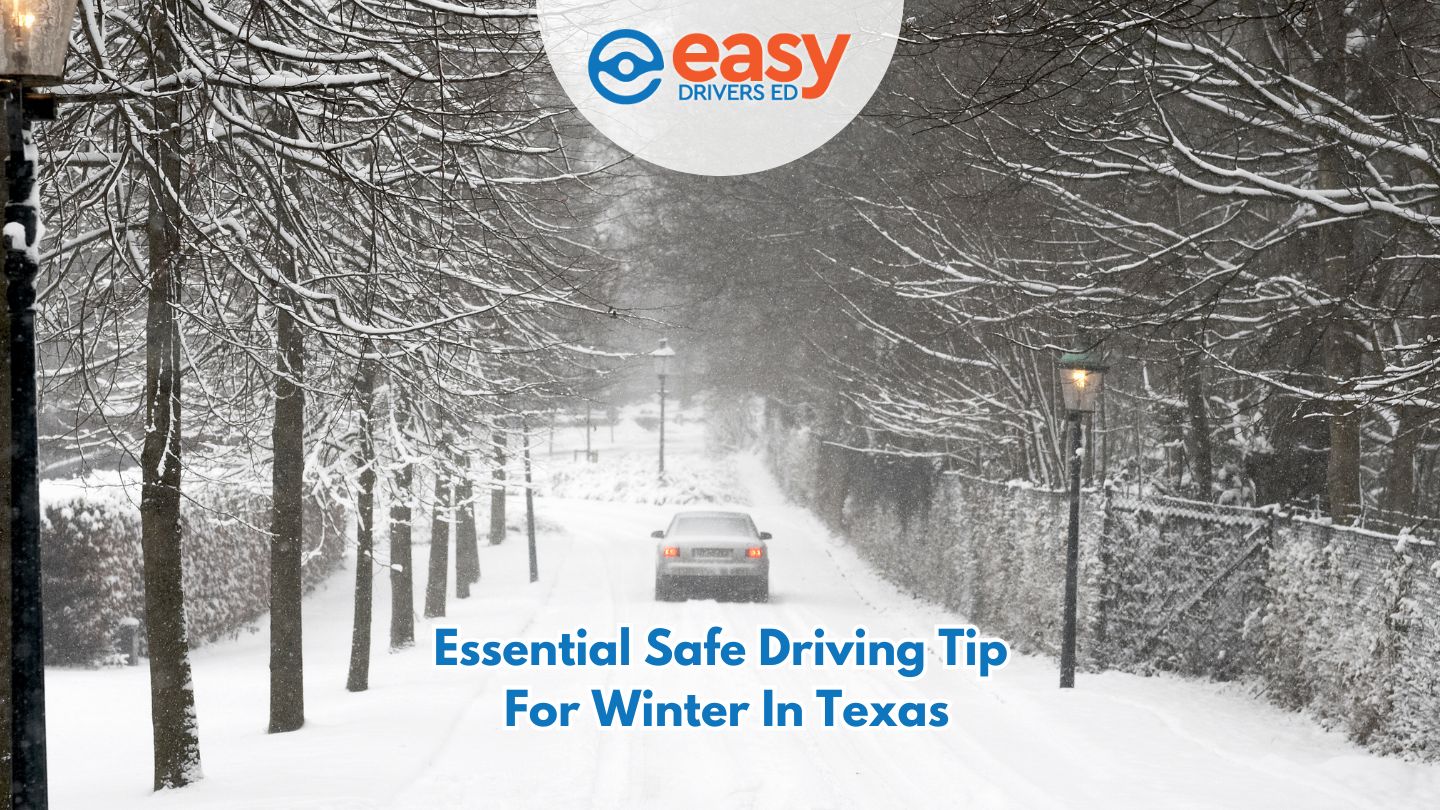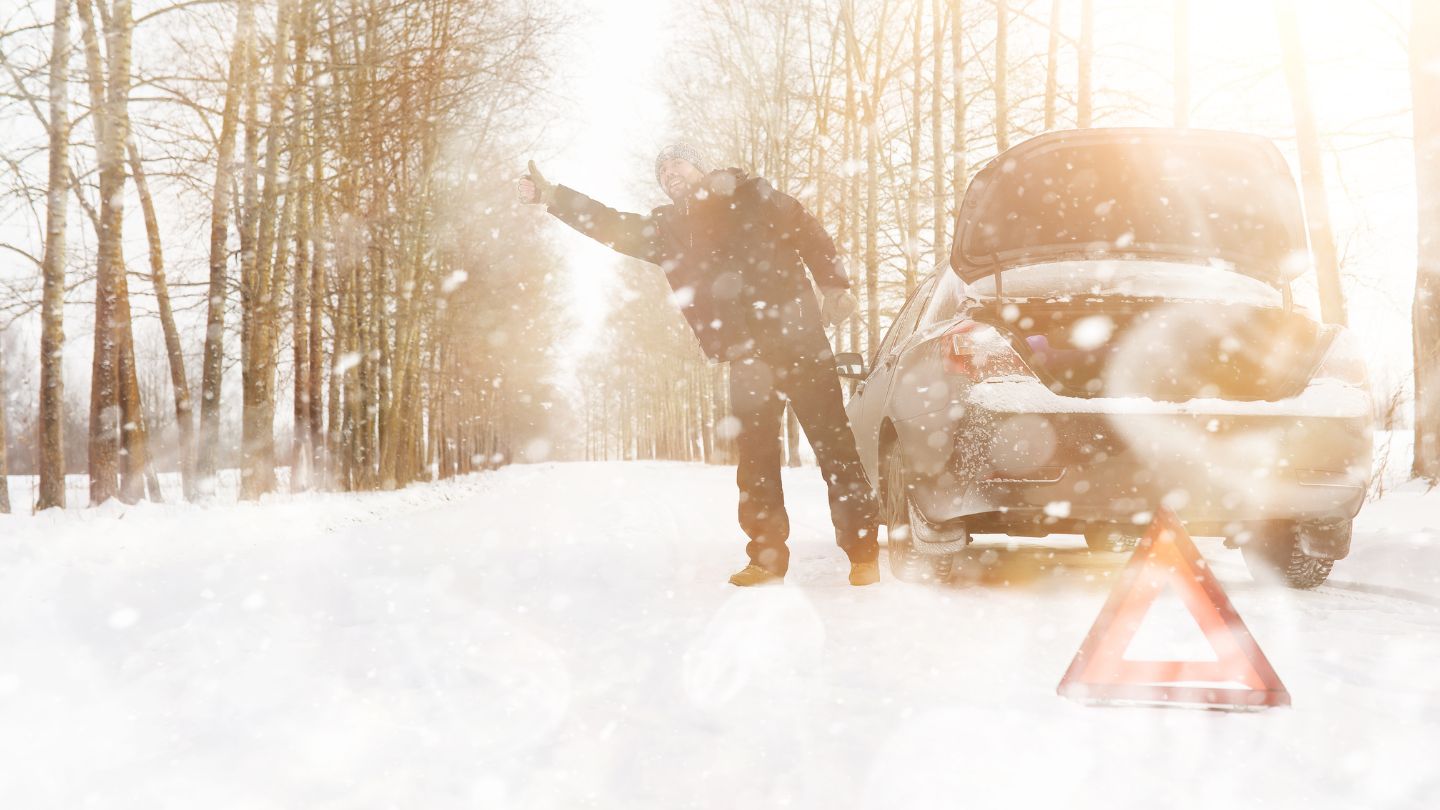Winter in Texas can be unpredictable, with sudden weather changes and occasional ice storms. This guide delivers essential, safe driving tips for winter in Texas. You’ll learn how to adjust your driving speed, prepare your vehicle, and stay safe in emergencies. Stay informed and stay safe on the winter roads.
Key Takeaways
- Adjust speed and following distance to enhance control and reduce accident risks on icy roads.
- Prepare your vehicle for winter by checking the battery, tires, and visibility-enhancing equipment.
- Keep an emergency kit in your car, including basics like jumper cables, warm clothing, and food supplies for winter breakdowns.
Adjust Your Speed and Following Distance
Navigating winter roads requires drivers to adjust their speed, adhere to speed limits, and maintain a greater following distance than usual. Reduced speeds allow better control of your vehicle, minimizing the risk of skidding or losing traction on icy surfaces. Additionally, increasing the gap between vehicles provides sufficient time to react to sudden stops or unexpected road hazards.
Relying on cruise control during icy conditions is not advisable, as it can lead to sudden loss of traction. This is particularly important on bridges and overpasses, which tend to freeze faster than regular roads. Following these practices ensures better control, reduces accidents, and contributes to overall road safety.
Prepare Your Vehicle for Cold Weather
A professionally serviced vehicle is essential for safe winter driving. Automotive experts recommend checking the battery to ensure it can handle the strain of colder weather. Professionals can test your battery’s capacity and clean any corrosion to maintain an optimal connection. They can also inspect your vehicle’s heating and defrosting systems, ensuring clear visibility and a warm cabin throughout the season. Additionally, it is important to check the spare tire and ensure it is properly inflated.
Winter tires are another critical investment, providing superior traction on icy roads. Tire professionals can check the tread depth, inflate tires to recommended levels, and replace worn-out tires to maximize safety. By trusting certified technicians to perform these checks; you can ensure your car is prepared to handle winter weather challenges effectively. It is also crucial to maintain windshield wipers and consider heavy-duty winter wipers for effective snow and ice removal.
Equipping your vehicle with tools like ice scrapers and snow brushes is essential for clearing snow or ice. However, larger issues, such as ice buildup around the car or damage from winter storms, are best addressed by professionals who can assess and resolve the situation safely and efficiently.
Essential Winter Supplies for Your Car
Carrying a winter emergency kit is critical for staying safe in case of unexpected breakdowns. While you can gather some basics like warm clothing and non-perishable snacks, professional roadside assistance services are indispensable in winter emergencies. They can provide towing, jumpstarts, and tire changes in dangerous conditions where attempting DIY fixes may put you at risk. Additionally, always maintain a safe distance from snow plows, as they move slowly, make wide turns, and stop frequently.
Include tools like jumper cables, but rely on professionals to handle tasks requiring precision and expertise. Similarly, having flares and a flashlight in your car enhances visibility and safety while waiting for help to arrive. Trusting professionals during emergencies ensures that your car receives proper care, reducing the risk of further issues.
Check Weather Conditions Before Traveling
Checking weather forecasts before driving is critical during winter weather conditions. Professional services, such as navigation apps with real-time weather and traffic updates, can provide insights into hazardous conditions or road closures. These resources ensure that you are fully informed about your route and can plan accordingly.
In addition to monitoring the weather, keep your vehicle ready for delays by filling the gas tank and maintaining emergency supplies. Professionals at service stations can inspect your fuel system and ensure everything is in working order, helping you avoid potential issues caused by condensation or frozen fuel lines.
Safe Practices During Snow and Ice
Driving on snowy or icy roads demands heightened vigilance. Vehicles equipped with antilock braking systems (ABS) perform best when drivers apply steady pressure to the brake pedal. For non-ABS vehicles, certified driving instructors recommend pulsing the brakes gently to retain control and avoid skidding.
Investing in high-quality winter wiper blades and ensuring professional installation contributes to clear visibility. These blades are specifically designed to handle heavy snow and ice, which is essential for safe driving. Additionally, routine checks by certified technicians can confirm that your windshield and defrosting systems are functioning optimally.
If forecasts predict severe weather, consider delaying your travel plans. Relying on professional advice from weather services or transportation authorities ensures you make informed decisions.
Handling Emergencies on the Road
Professional roadside assistance can make all the difference during winter emergencies. If you’re stranded, it’s best to stay in your vehicle and signal for help using flares or reflective warning triangles. Rescue teams are equipped to handle such situations safely and efficiently.
Ensure your vehicle’s exhaust pipe is free of snow to prevent issues like carbon monoxide buildup. Professionals can inspect and clear these obstructions during regular maintenance to prevent dangerous conditions. With the right preparation and access to expert help, emergencies can be managed effectively and safely.
Avoid Risky Driving Behaviors
Avoiding distractions is vital for safe winter driving. Texting or engaging in activities that take your attention off the road can increase the likelihood of accidents. Certified driving programs emphasize the importance of focus and situational awareness, helping drivers develop safer habits.
Alcohol or drug consumption while driving is especially dangerous in winter conditions. Professional driver education programs stress the impact of impaired driving and provide strategies to avoid risky behaviors. Wearing a seat belt is another critical safety measure; professionals highlight its role in minimizing injuries during collisions.
By avoiding these behaviors, you significantly reduce the risks associated with winter driving.
Keeping Your Gas Tank Full
Maintaining your gas tank at a minimum of half capacity during the winter season is essential for preventing issues like frozen fuel lines and ensuring that your heater remains functional in emergencies. Professionals recommend keeping the tank at least half full to reduce the risk of condensation forming inside the tank, which can lead to fuel line blockages in colder weather.
Service professionals can inspect your fuel system during routine maintenance to ensure it’s functioning optimally. They can check for potential issues, such as condensation buildup or fuel pump wear, that may compromise performance. Having a full tank not only protects your fuel pump—using gasoline as a coolant—but also ensures consistent vehicle performance during freezing temperatures.
While gasoline typically won’t solidify until reaching extremely low temperatures, cold weather can still affect the fuel system’s efficiency. Trusting certified technicians to monitor and maintain your fuel system provides peace of mind and enhances safety while navigating winter driving conditions.
Maintaining Clear Visibility
Clear visibility is crucial for safe winter driving. Professionals recommend switching to winter-rated windshield wiper blades and washer fluid, as these products are designed to perform in extreme cold. Certified mechanics can replace worn wipers and inspect defrosters to ensure optimal performance.
Another important aspect of visibility is checking and maintaining all vehicle lights. Professionals should inspect headlights, brake lights, and turn signals to ensure they function properly. These steps enhance safety for you and other drivers on the road.
Proper Use of Floor Mats
Ensuring the correct placement of floor mats is essential for safe winter driving. Poorly fitted mats can slide and obstruct the accelerator or brake pedal, creating significant safety hazards. Professional technicians can secure your floor mats according to the manufacturer’s guidelines, ensuring they remain in place during vehicle operation.
Experts recommend using durable, rubberized floor mats for winter driving. These mats are specifically designed to handle snow, slush, and water, providing enhanced traction and preventing moisture from seeping into the vehicle’s carpet. Their easy maintenance also makes them ideal for frequent cleaning during the winter months.
By having professionals inspect and install floor mats properly, you can prevent potential accidents and increase your comfort and safety while navigating winter roads.
Plan for Electric Vehicles
Managing electric vehicles (EVs) during the winter months requires extra attention to ensure optimal performance and reliability. Cold weather can reduce battery efficiency and prolong charging times as the vehicle’s system adjusts to protect the battery in low temperatures. To avoid running out of charge, rely on professional advice or EV-specific tools to plan your route strategically, incorporating stops at public charging stations as needed. Many apps offer real-time information on charging station availability to streamline your journey.
Storing your EV in a temperature-controlled garage is another effective strategy to maintain battery efficiency and reduce charging delays. Certified EV technicians can inspect and recommend storage and maintenance practices tailored to your vehicle’s needs. Additionally, some EV models include pre-conditioning features that warm the battery before use, enhancing performance. Professionals can guide you on how to use these features effectively to balance performance and power conservation.
By consulting with EV specialists and planning ahead, you can ensure your electric vehicle remains dependable and efficient throughout the winter season.
Avoiding Carbon Monoxide Poisoning
Preventing carbon monoxide poisoning during the winter months is vital for driver and passenger safety. Carbon monoxide, a colorless and odorless gas, can accumulate in enclosed spaces when a vehicle is running, posing serious health risks. Professionals strongly advise against operating your vehicle in confined spaces, such as a closed garage, to minimize exposure.
Additionally, snow or ice blocking the exhaust pipe can force carbon monoxide back into the vehicle cabin. During routine maintenance, certified technicians can inspect your vehicle’s exhaust system to ensure it is clear and functioning properly. They can also address any potential leaks that might compromise safety.
If you must run your engine while stationary, slightly crack a window to allow fresh air circulation and reduce the risk of carbon monoxide buildup. Following these professional recommendations helps safeguard against the potentially lethal dangers of carbon monoxide poisoning, ensuring a safer winter driving experience.
Summary
Driving safely during winter in Texas demands thorough preparation, heightened alertness, and the right professional assistance. By adjusting your speed and maintaining safe distances, entrusting experts with vehicle preparation, and equipping your car with essential emergency supplies, you can navigate the challenges of winter roads with confidence. Always check weather updates and rely on professionals for vehicle maintenance and repairs to ensure a safe journey.
At EasyDriversEd, we are committed to your safety. We offer comprehensive driver education tailored to all conditions, including winter driving. Our driver’s education online in Texas provides trusted courses and valuable insights for confident, informed driving. Stay safe this winter with EasyDriversEd. Contact us today to learn more about how we can help you master safe driving skills.
Frequently Asked Questions
1. How can I tell if my tires are safe for winter driving?
Check the tire tread depth using a simple coin test. For optimal grip, the tread should be at least 6/32 of an inch. Professional inspections can ensure your tires are winter-ready.
2. What should I do if my car starts sliding on ice?
If your car slides, gently steer in the direction you want to go and avoid slamming the brakes. Vehicles with ABS allow for firm braking, but without ABS, pump the brakes gently.
3. Why is storing an emergency kit in my car essential for winter?
An emergency kit ensures you’re prepared for breakdowns or delays. It provides items like warm clothing, non-perishable food, and visibility tools that can significantly improve safety during winter conditions.



